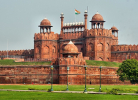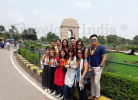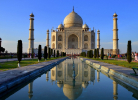Delhi - India’s Historical City!
Delhi is the capital city of India and is regarded as the heart of the nation. The city is popular for its enriched culture and heritage. The city hosts some famous historical monuments and is developing with the passing of time.
The influence of religious diversity can be seen in the city along with the cultural impact of the Mughal, the ancient Indian and the British. There are many beautiful gardens in the city, away from pollution and busy city life that provide opportunities to walk leisurely in the midst of greenery.
The capital city is divided into two sections popularly known as Purani Dilli or Old Delhi and Nayi Dilli or New Delhi. Old Delhi is popular for its ancient culture and monuments along with its overcrowded gastronomical lanes. Let’s have a quick peek into the different aspects of Delhi below
People of all ages can enjoy there as it has something for everyone to compliment their interests. There is nothing like best time to visit this majestic land but the period between mid October to mid March is considered as an ideal time for those who are not familiar with the summers of Rajasthan. It is because the weather remains pleasant at this time.
Traveling to Rajasthan in summers is not recommended as it could be an uncomfortable trip for those hailing from cold countries and states. The temperature in Rajasthan varies from 45°C to 48°C during summer. May and June are considered as the hottest months of Rajasthan. During summer, the days remain extremely hot but the nights remain chilled.
Old Delhi
Mughal Emperor Shahjahan founded Old Delhi in 1639 which was formerly known as Shahjahanabad. Till the end of Mughal dynasty it remained the capital of the Mughals. During ancient times, the city was known for housing exquisitely designed mosques, beautiful gardens, and magnificent mansions of members and nobles of the royal court. Though this part of Delhi has become extremely crowded yet it symbolizes the heart of Delhi.
The Mughals built many palaces and forts in Delhi. The wall city was built by Shah Jahan in between 1638 to 1649, including the Chandni Chowk and the Lal Qila. The original cantonment of Delhi was at Daryaganj which later shifted to Ridge area. Old Delhi had the first wholesale market and the first hardware market was opened in Chawri Bazaar in the year 1840. Then the next wholesale market was opened at Khari Baoli which was of dry fruits, herbs and spices in 1850. Daryaganj also had a Phool Mandi (Flower Market), established in 1869. Though the area is small and densely populated it holds much importance.
The capital of India was shifted to Calcutta post 1857 revolt and after the fall of the Mughal Empire. It remained the capital until 1911. So, Lutyens’ Delhi was developed after the change was declared. It was developed in New Delhi located south-west of Shahjahanabad. Therefore, the Old Delhi was named so and New Delhi was considered as the seat of national government then. In the year 1931, it was officially inaugurated. Some people moved out of the walled city by 1930s as it became congested and areas around the city were getting developed.
















